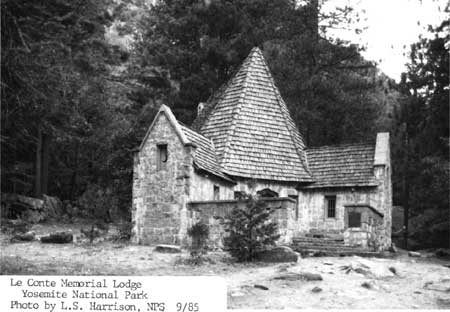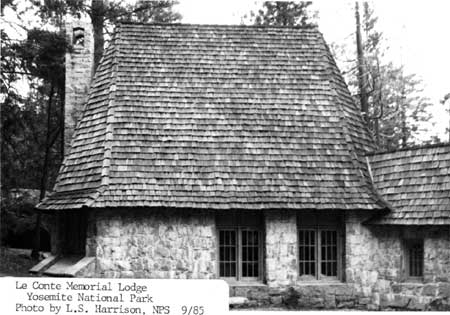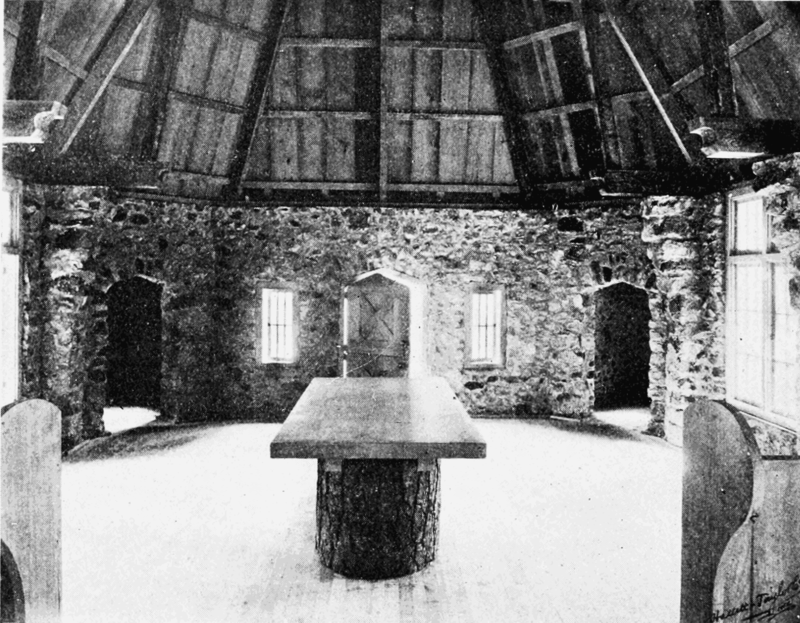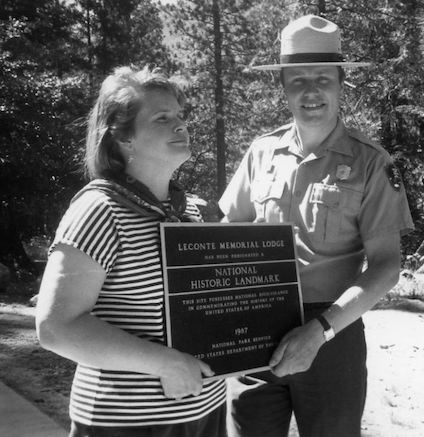
Here, traveler, pause upon thine upward way,
Enter and rest, and search thy soul to-day.
High are the mountains where thy feet would fare
Let wisdom lead, that peace may bless thee there.
- Harriet Monroe, Dedication quatrain, 1904
The Sierra Club has had a long and intimate history with Yosemite National Park, of which the Yosemite Conservation Heritage Center (formerly LeConte Memorial Lodge) is one important part. Even the logo of the Sierra Club, first designed by architect Willis Polk in 1894, depicts a giant sequoia and Yosemite's Half Dome. Today, visitors to the Yosemite Conservation Heritage Center have a spectacular view of Half Dome, as well as Yosemite Falls, from the porch.
In 1898, Yosemite Valley, not yet included in the boundaries of Yosemite National Park, was operated by the State of California, through the State Board of Yosemite Commissioners. That spring, the commissioners asked the Sierra Club, founded in 1892, to provide a public reading room and information center for Yosemite visitors. Sinning's Cottage, a small building located on the southside of the Valley on what is now Southside Drive, near Sentinel Bridge, in what is known as the old Yosemite Village, ensured high visibility to visitors and proved to be an excellent location.
Originally built before 1874 for Henry Stegman’s seed store, the building was leased in 1877 by Adolph Sinning (1813-1889), a German woodworker, who lived there and sold "beautiful and dainty souvenirs in California woods." The Sierra Club furnished the cottage with a small library, a herbarium, photographs, and maps, and hired an attendant for the summer season. William E. Colby, a young law school graduate, who would go on to serve for 60 years as a Sierra Club leader, was selected as the first attendant. The Sierra Club and the State Board of Yosemite Commissioners shared the responsibility of paying Colby's salary.
In addition to acting as caretaker for the newly established "reading room," Colby assisted the Guardian of the Valley—a paid official appointed by the Commissioners—"by directing campers to their grounds, and giving general information concerning the Valley to visitors." Although he retired after the 1896 season, the original Guardian was Galen Clark, a charter member of the Sierra Club. A few years after William Colby, Galen Clark himself served as the custodian at Sinning's Cottage.
The Sierra Club operated the public reading room and information center out of Sinning's Cottage until the LeConte Memorial Lodge was built. The chairman of the Yosemite Commissioners, Abbott Kinney, commented, "The Sierra Club Building is a complete success, and should bring the Commission into sympathetic touch with the lovers of nature in California... The Sierra Club will be a center of information for travel into the wonders of these peaks, volcanoes of the past, glaciers, rivers, and lakes.” Today the Sierra Club still operates a reference library open to the public at its headquarters in Oakland, named for William Colby, as well as the extensive library within the Yosemite Conservation Heritage Center.
In 1901, the Sierra Club started the first of its national Outings, which are still an important offering of the Sierra Club today. The Sierra Club's first president, John Muir, reasoned, "If people in general could be got into the woods, even for once, to hear the trees speak for themselves, all difficulties in the way of forest preservation would vanish."
The first outing was to trek from Yosemite Valley to Tuolumne Meadows. On the eve of the gathering in Curry Village, Joseph LeConte, a charter member of the Sierra Club, died of a heart attack at the age of 76. A native of Georgia, LeConte grew up on Woodmanston, a slave-holding plantation near Savannah. He moved to California after the Civil War, disgusted by the movement toward racial equality begun during Reconstruction. A professor of geology at the University of California, LeConte was also a vocal proponent of theories of “scientific” racism that he used to rationalize the disenfranchisement and segregation of Black people.
LeConte had first visited Yosemite in 1870 with 10 of his students. In Yosemite Valley he met and befriended John Muir, who traveled with the party for 10 days.

As a memorial to Joseph LeConte, the Sierra Club arranged, in cooperation with the State Board of Yosemite Commissioners, to erect a permanent stone building to replace Sinning's Cottage, as a reading room and information center.
In 1902, Sierra Club members were taxed $1.00 for the building fund. Additional funding for LeConte Memorial Lodge was contributed by prominent San Francisco merchants; students, alumni, and faculty from the University of California; faculty from Stanford University, mining engineers; geologists, and LeConte's relatives and personal friends. Caroline Elizabeth LeConte, LeConte's widow, contributed 28 gold nuggets given to her husband on the occasion of their golden wedding anniversary from several former students in South Africa. Mrs. LeConte believed that there was no better use than to contribute to the "Yosemite Sierra Club building" being built to honor her husband.
The memorial was built in Yosemite's Camp Curry over the fall and spring of 1903-1904 but was moved in 1919 to its present location across from the Housekeeping Cabins.
John White, a Berkeley architect, designed the building. Following the First Bay Tradition of architecture. White subscribed to the theory that the design should be derived from native building materials and exposed structure rather than decorative detail. The design for the building reflects these principles with its rough-hewn granite masonry and steep-pitched roof, which capture the color, texture, and verticality of the Yosemite Valley walls.
Dedicated on July 3, 1904, "there was a large attendance of Sierra Club members, owing to the fact that Yosemite Valley had been selected as the gathering-place for the 1904 Outing." The dedication exercises were simple but impressive. William E. Colby, the secretary of the Club, presided in the absence of John Muir, who was traveling around the world at the time.
An American flag was hung over the doorway, and the celebration was conducted in front of the building. Rev. C.T. Brown, of San Diego, gave the invocation. Addresses were delivered by Professor A.C. Lawson, who succeeded Professor LeConte as head of the Geological Department of the University of California, Mr. Alexander G. Eells, president of the Alumni Association, and Dr. G. K. Gilbert, of the US Geological Survey. Mr. Willoughby Rodman read a poem written for the occasion, and Miss Caroline Little sang Tennyson's "Splendor Falls on Castle Walls." Poet Harriet Monroe, of Chicago, and later the founder of Poetry magazine, read an original quatrain. Rev. Joseph Clemens pronounced the benediction. The exercises closed with the singing of "The Star-Spangled Banner." A bronze tablet inscribed to Joseph LeConte was inserted into the interior wall of the LeConte Memorial Lodge. Lemonade and popcorn were served.
Through the decades, the Yosemite Heritage Conservation Center has been cared for by Sierra Club members. As we have seen, the first caretaker at Sinning's Cottage, in 1898, was William E. Colby, the Club's long-time secretary and president from 1901-1961. The first caretaker of LeConte Memorial Lodge itself was Robert L. McWilliams, and the first chair of the Sierra Club's LeConte Lodge Committee was Edward T. Parsons. Perhaps the most recognized caretaker was Ansel Adams, who served from 1920 until 1923. Other notable early caretakers and committee leaders included Joseph N. LeConte ("Little Joe") and Marion Randall Parsons. Our current curator and more historical caretakers are identified on our curator page.
Since the dedication of the LeConte Memorial Lodge in 1904, the building has served as a focal point for Sierra Club members and all visitors to Yosemite National Park who advocate conservation and the national park idea. The Sierra Club was organized by many of the same persons who had originally lobbied for the establishment of Yosemite National Park, including Joseph LeConte, John Muir, Robert Underwood Johnson, and others. In October of 1892, in its first conservation campaign, the Club argued against, and ultimately defeated, a proposal to reduce the size of the newly established Yosemite National Park. In 1906, after a 14-year campaign, the Sierra Club influenced the California legislature and the US Congress to combine Yosemite Valley, still in state ownership, with the surrounding high country into the present national park. When the original park had been established in 1890, it did not include Yosemite Valley or the Mariposa Grove of giant sequoias. It was largely through the efforts of John Muir and the Sierra Club that these two areas were finally restored to the national park.
In 1913, the Sierra Club lost its campaign to prevent the flooding of nearby Hetch Hetchy Valley for a reservoir for the San Francisco water supply. The loss of that valley—Yosemite's Twin and much beloved by John Muir—ultimately benefited the cause of conservation and protection of our national parks. The grassroots nature of the anti-dam protest widened preservationist support tremendously. A vague general approval of wilderness hardened into a movement capable of sustained political action. Muir noted, "The conscience of the whole country was aroused from sleep." When dams were later proposed in Dinosaur National Monument and Grand Canyon National Park, Sierra Club campaigns successfully kept them out of the parks.

The Sierra Club welcomed the National Park Service when it was established in 1916, with Sierra Club member Stephen Mather as its first director and another Sierra Club member, Horace Albright, as assistant director and later a long-time director. In the decades that followed, this building continued to play an important part of National Park history. Beginning in 1919, the Sierra Club, together with the University of California, sponsored the "LeConte Memorial Lectures" in Yosemite Valley that ultimately became the basis for the National Park Service interpretive programs presented at national parks across the United States.
In 1955, Ansel Adams returned with Nancy Newhall to mount an exhibit, "This Is the American Earth," that represented the work of 32 photographers. The exhibition and refurbishing of the building were financed by Walter Starr, Sr., a long-time Sierra Club director who had earlier supported the publication of Ansel Adams’s book Sierra Nevada: The John Muir Trail, and whose son, Walter A. "Pete" Starr, Jr. wrote the first definitive guide to the John Muir Trail, published in 1934. The subsequent exhibition book of the American Earth exhibit was designed and written by Newhall and David Brower, then executive director of the Sierra Club, and was published in 1960. This book was the first of the Sierra Club's award-winning "Exhibit Format" book series and is a testament to the need for conservation and protection of the environment. "This Is the American Earth is one of the great statements in the history of conservation," proclaimed Supreme Court Justice William O. Douglas. It has been reprinted several times in the subsequent decades and remains an inspirational combination of text and photography.

The Yosemite Conservation Heritage Center was designated a National Historic Landmark in 1987. This honor was awarded explicitly for its design, which complemented the natural surroundings, and for the history of the Sierra Club and its role in Yosemite Valley and the national park system. A dedication ceremony for the installation of a plaque confirming this honor was held in June 1990. Sierra Club president Sue Merrow and Yosemite National Park superintendent Michael Finley presided over this dedication ceremony, which was attended by the entire Sierra Club Board of Directors.
In 1998, the Sierra Club completed renovations of the building’s interior lighting system. Antiquated (and ugly!) lighting installed in the 1930s was replaced with Craftsman-style chandeliers and box lighting in keeping with the original architectural style. This project was made possible only by the generous donations of donors and the dedicated volunteer efforts of Sierra Club volunteer George Pettit.
In 2002 and 2003, the Sierra Club expanded the book collection in the library with generous donations from Sierra Club Books, members of the LeConte Memorial Lodge Committee, the Wiebe Foundation, and members, volunteers, and friends of the Sierra Club. The Yosemite Conservation Heritage Center continues to offer to the public an ongoing series of free public programs.
The building celebrated its centennial in 2004 and was rededicated in a special ceremony attended by National Park Service officials, the Sierra Club vice-president, and many volunteers.
In 2016, the Sierra Club requested the National Park Service to rename the building due to Joseph LeConte’s unacceptable views about race. The National Park Service accepted this proposal, and renamed the building the Yosemite Conservation Heritage Center.
As Sierra Club deputy senior director of program policy and internal governance Bruce Hamilton explained:
“While Joseph LeConte is best known and remembered for his scholarship, he was also a slave owner, supporter of the Confederacy and Jim Crow policies, and prominent proponent of social Darwinist theories about racial inferiority. For decades after the Civil War, including when he was teaching at the University of California and serving on the Sierra Club Board of Directors, LeConte used his academic credentials to promote theories that we find repugnant today.
“Ensuring that our parks are a welcoming and inclusive place for everyone is a core value of the Sierra Club. We are committed to advancing a park system that tells our diverse stories and ensures that our parks are places that can be accessed and enjoyed by everyone. While Joseph LeConte will remain an important part of the history of Yosemite, we feel it is unacceptable to continue to have a public education center in the park named in honor of a man who advocated for theories about the inferiority of nonwhite races. To do so would be counter both to our values and to our desire to promote inclusivity in our parks. For this reason, at the request of the Sierra Club, the National Park Service has taken the unusual step of renaming this building, which will now be known as the Yosemite Conservation Heritage Center.”
Although motivated by a rejection of Joseph LeConte's writings on racial topics, the name change also more accurately represents the educational mission of the Center. The Center tells the stories of many Sierra Club leaders who have promoted protection for Yosemite and other national parks. Current exhibits cover John Muir, LeConte's son Joseph N. LeConte ("Little Joe"), Robert Underwood Johnson, William Colby, Edward Parsons, Marion Randall Parsons, Aurelia Harwood, Ansel Adams, David Brower, Dr. Edgar Wayburn, and other important Sierra Club leaders. The Center also highlights the Sierra Club's current endeavors to combat global climate change and support environmental justice.
Through interpretive environmental education programs and projects, the legacy of stewardship will continue. Through the service of many Sierra Club volunteers and one staff curator, the Center invites visitors to enjoy a conservation and natural history library, exhibits about the history of the Sierra Club and its current endeavors, and a children's library corner. The center continues to inspire current and future generations to enjoy, explore, and protect the natural world.